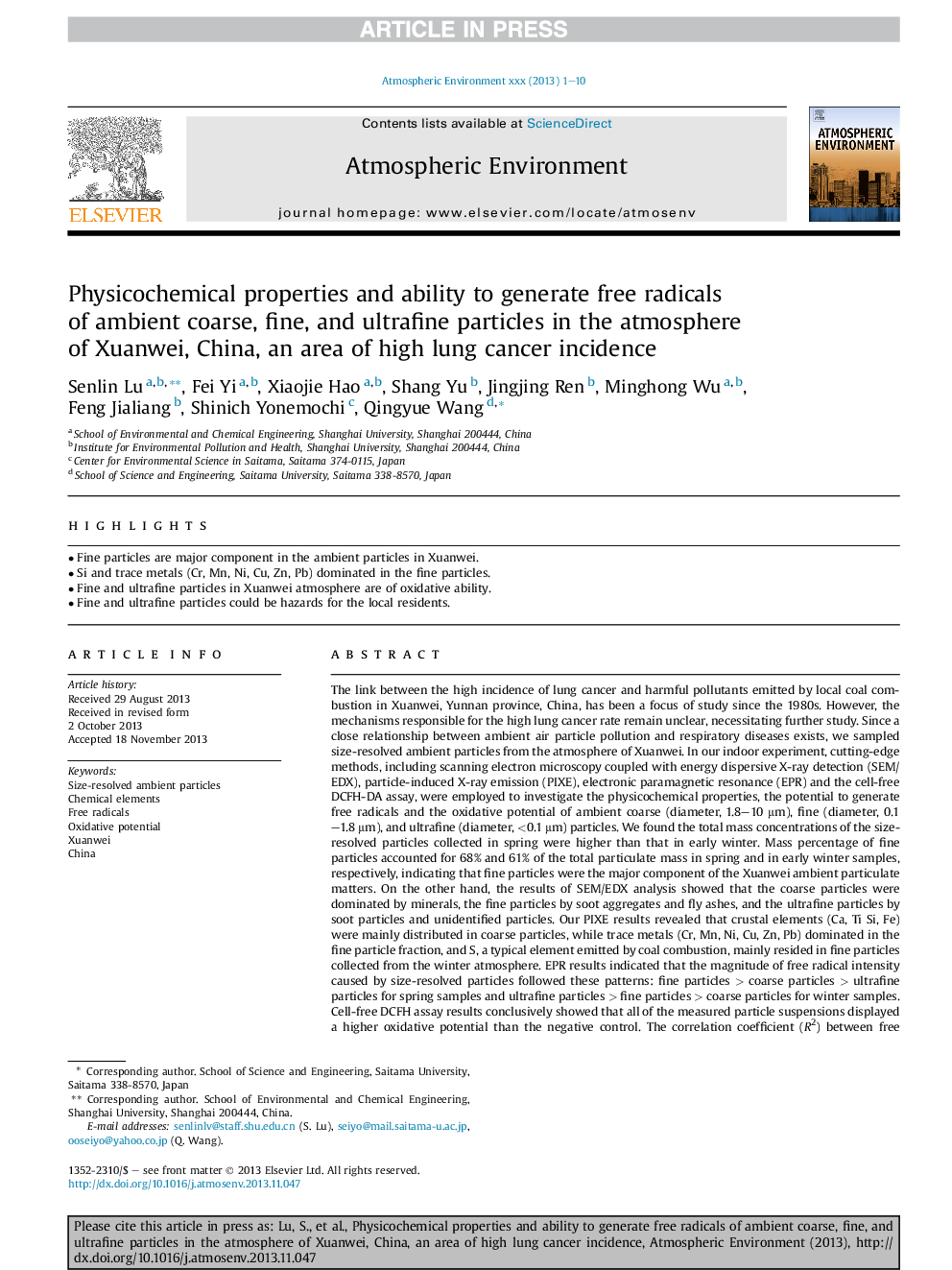| کد مقاله | کد نشریه | سال انتشار | مقاله انگلیسی | نسخه تمام متن |
|---|---|---|---|---|
| 6339866 | 1620374 | 2014 | 10 صفحه PDF | دانلود رایگان |
عنوان انگلیسی مقاله ISI
Physicochemical properties and ability to generate free radicals of ambient coarse, fine, and ultrafine particles in the atmosphere of Xuanwei, China, an area of high lung cancer incidence
دانلود مقاله + سفارش ترجمه
دانلود مقاله ISI انگلیسی
رایگان برای ایرانیان
کلمات کلیدی
موضوعات مرتبط
مهندسی و علوم پایه
علوم زمین و سیارات
علم هواشناسی
پیش نمایش صفحه اول مقاله

چکیده انگلیسی
The link between the high incidence of lung cancer and harmful pollutants emitted by local coal combustion in Xuanwei, Yunnan province, China, has been a focus of study since the 1980s. However, the mechanisms responsible for the high lung cancer rate remain unclear, necessitating further study. Since a close relationship between ambient air particle pollution and respiratory diseases exists, we sampled size-resolved ambient particles from the atmosphere of Xuanwei. In our indoor experiment, cutting-edge methods, including scanning electron microscopy coupled with energy dispersive X-ray detection (SEM/EDX), particle-induced X-ray emission (PIXE), electronic paramagnetic resonance (EPR) and the cell-free DCFH-DA assay, were employed to investigate the physicochemical properties, the potential to generate free radicals and the oxidative potential of ambient coarse (diameter, 1.8-10 μm), fine (diameter, 0.1-1.8 μm), and ultrafine (diameter, <0.1 μm) particles. We found the total mass concentrations of the size-resolved particles collected in spring were higher than that in early winter. Mass percentage of fine particles accounted for 68% and 61% of the total particulate mass in spring and in early winter samples, respectively, indicating that fine particles were the major component of the Xuanwei ambient particulate matters. On the other hand, the results of SEM/EDX analysis showed that the coarse particles were dominated by minerals, the fine particles by soot aggregates and fly ashes, and the ultrafine particles by soot particles and unidentified particles. Our PIXE results revealed that crustal elements (Ca, Ti Si, Fe) were mainly distributed in coarse particles, while trace metals (Cr, Mn, Ni, Cu, Zn, Pb) dominated in the fine particle fraction, and S, a typical element emitted by coal combustion, mainly resided in fine particles collected from the winter atmosphere. EPR results indicated that the magnitude of free radical intensity caused by size-resolved particles followed these patterns: fine particles > coarse particles > ultrafine particles for spring samples and ultrafine particles > fine particles > coarse particles for winter samples. Cell-free DCFH assay results conclusively showed that all of the measured particle suspensions displayed a higher oxidative potential than the negative control. The correlation coefficient (R2) between free radical intensity and fluorescent intensity generated by the size-resolved particles was 0.535 and 0.507 for the spring and winter seasons, respectively, implying that ambient air particles in the Xuanwei atmosphere have the ability to generate free radicals, and fine and ultrafine particles could be hazardous to local residents.
ناشر
Database: Elsevier - ScienceDirect (ساینس دایرکت)
Journal: Atmospheric Environment - Volume 97, November 2014, Pages 519-528
Journal: Atmospheric Environment - Volume 97, November 2014, Pages 519-528
نویسندگان
Senlin Lu, Fei Yi, Xiaojie Hao, Shang Yu, Jingjing Ren, Minghong Wu, Feng Jialiang, Shinich Yonemochi, Qingyue Wang,